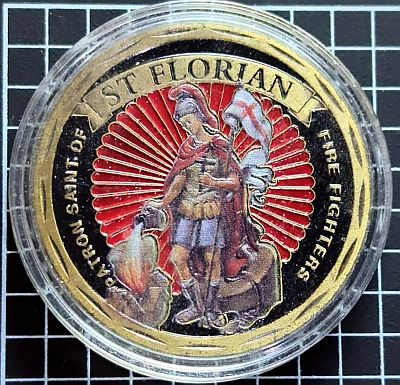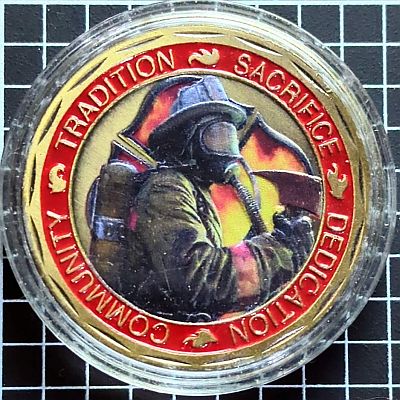The Patron Saint of Firefighters
Obverse

The obverse features the text “SAINT FLORIAN” and “Patron Saint of Fire Fighters” around the edge. In the centre is a traditional image of Saint Florian pouring water out of a bucket onto buildings.
Note: “firefighter” is usually written as one single word, both in UK and US English. The term “Fireman” is discouraged – there are many female firefighters! But who was Florian, and how did he become the Patron Saint of firefighters?
Florian was born in 250 A.D. in Cetium, what is now Austria. As a young man he joined the Roman army. He proved to have the makings of quickly climbing the ranks. The emperor at the time—Diocletian—recognized his dedication and ability to work well with people, and appointed Florian to a high administrative post in Noricum, now part of Austria.
In addition to commanding the ranks of the Northeastern Roman army, Florian was tasked with organizing firefighting brigades. Florian’s men weren’t the first group of firefighters in Rome, but they were certainly the best. Florian was so dedicated to protecting Roman citizens that he organized and trained an elite group of soldiers whose sole duty was to fight fires.
Florian was a Christian at a time when this was punishable by death, particularly under Diocletian. Florian’s faith, while secret, was so strong that he saved an entire town from being burned by fervently praying and throwing a single bucket of water onto the flames.

(I like this image of St Florian using his bucket to help modern firefighters fight a fire. This image from UFUSA.com)
Diocletian was shocked to learn that Florian did not carry out his orders to persecute all Christians in the area, and, thus, was sentenced to death by fire. Standing on the funeral pyre, Florian is reputed to have challenged the Roman soldiers to light the fire, saying “If you do, I will climb to heaven on the flames.” Apprehensive to his words, instead of burning Florian, they drowned him. His body was later retrieved by Christians and buried at an Augustinian monastery near Lorch.
His body, recovered and buried by a pious woman, was eventually removed to the Augustinian Abbey of St. Florian, near Linz. It is said to have been translated to Rome, and Pope Lucius III, in 1138, gave some of the saint’s relics to King Casimir of Poland and to the Bishop of Cracow
Soon after this, a person was saved from a fire by invoking Saint Florian’s name. Since then, Florian has been invoked against fire and is the patron saint of firefighters and floods. St. Florian’s feast day is May 4th.
While the name Florian is not common today, it is worth nothing that Saint Florian wasn’t the only one Florian in the Roman Empire. During his lifetime, there was a Roman Emperor called Marcus Annius Florianus (or Florian) who ruled in 276 A.D. He was brother of Emperor Tacitus and only ruled for 88 days.
Reverse

The reverse features a modern firefighter, wearing breathing apparatus and holding an axe. Behind the firefighter is a “Florian Cross” full of fire. Around the edge are some of the qualities valued in firefighters: Sacrifice, Dedication, Community and Tradition.
St. Florian is well known by most firefighters today. As well as being the feast day of St. Florian, May 4th is also known as “International Firefighters day“. This is a day to thank and remember firefighters who have gone before and lost their lives.
Firefighting in Rome
Fires have been a threat throughout human history. In ancient Rome, the poet Juvenal lamented of city living:
“No, no, I must live where there are no fires, no nightly alarms. Ucalegon below is already shouting for water… smoke is pouring out of your third-floor attic above, but you know nothing of it; for if the alarm begins in the ground-floor, the last man to burn will be he who has nothing to shelter him from the rain but the tiles…”
Managing the constant threat of fire in Rome had always been the responsibility of those who had the wealth and the power to do so. During the Republic, small bands of men were organised under the command of the tresviri nocturni and the aediles in order to fight fires in the city. The aedile Marcus Egnatius Rufus who, in 19BC, also commanded his own gang of slaves for the specific purpose of fighting fires.
It is estimated there were a daily average of 100 fires that required the attention of the Vigiles, yet only 2 of these 100 were actually serious threats to the city.
After a devastating fire in A.D. 6, Emperor Augustus is credited with creating the first official permanent fire brigade in Rome. He gathered a corps of 3,500 freedmen, later doubled that number, and armed them with fire-fighting equipment, whilst also organising them into seven Cohorts stationed in seven barracks throughout the city. They became colloquially dubbed the Sparteoli, an endearing nickname meaning the “little bucket fellows”. Under Augustus, Rome was divided into 14 regions. Thus, he charged each of the seven cohorts with protecting two regions. Every cohort included 500 men, and was managed by a tribune, and they were all under the command of an equestrian known as the Praefectus Vigilum. An account of the duties of the Praefectus Vigilum states:
“It should be realised that the prefect of the city guard is obliged to keep watch throughout the whole night… equipped with hooks and axes, and he is obliged to admonish all occupiers not to let fires break out through some carelessness. Moreover, he is under orders to warn everyone to have a supply of water ready in an upstairs room.”
Their services were so effective that, according to Suetonius, Claudius could see their potential uses elsewhere and established cohorts in Ostia and Puteoli, harbours which Rome depended on for much of their supplies.
Four physicians were attached to each cohort. Trumpeters (bucinatores), about five per cohort, were essential for communication. They would warn inhabitants and summon assistance from other patrolling units or from the barracks. Runners will also have been used, and a few horses. To fight a small fire about 40 men would be needed, for a rapidly spreading fire 75, for the largest 150. Vigiles were also night watchmen, acting as police against thieves and burglars, thus they were equipped with a short sword, as used by other Roman soldiers.
Equipment the Vigiles used included mainly buckets, sponges, and brooms, as well as heftier instruments such as siphona and ballistae, used to destroy buildings in order to create firebreaks. Similar methods were used right up until the development of the first fire pumps in the 1700s.


Leave a Reply